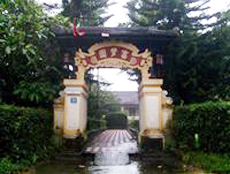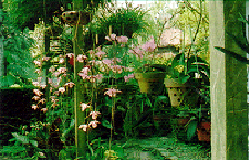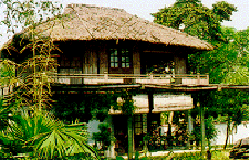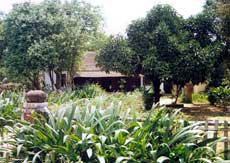Hue is one of a few cities in Vietnam which have retained images of their ancient royal heritage and artifacts. Beside the well-known historical royal citadels, temples and pagodas, Hue is also exposing its traditional and beautiful garden houses in residential areas.
 The system of Hue gardens consists of house gardens, pagoda gardens, tomb gardens, and palace and royal gardens, which were built on both sides of the Perfume River but mainly concentrated in Ngoc Ho, Nguyet Bieu, Luong Quan, Kim Long, Duong Xuan and Vi Da. According to statistical figures, Hue has 1,778 garden houses, the smallest comprises an area of 400 m2 and the largest is 8,700 m2. Dozens of famous garden houses have been designated as “cultural heritage sitesâ€.
The system of Hue gardens consists of house gardens, pagoda gardens, tomb gardens, and palace and royal gardens, which were built on both sides of the Perfume River but mainly concentrated in Ngoc Ho, Nguyet Bieu, Luong Quan, Kim Long, Duong Xuan and Vi Da. According to statistical figures, Hue has 1,778 garden houses, the smallest comprises an area of 400 m2 and the largest is 8,700 m2. Dozens of famous garden houses have been designated as “cultural heritage sitesâ€.
Hue garden houses, many of which were built hundreds of years ago, accommodated noble classes, upper strata, and Confucian scholars from all over the country.
The diversity of the garden houses reflects the house owner’s life style. However, the whole garden area is arranged in line with eastern geomancy rules and a Hue garden house usually consists of main and back entrances in the surrounding fence, and a small wall, rockwork and plants in the front yard and the house itself.
A tree often grows in front of the home’s entrance gate. The rather high gate is topped with a small roof, large enough to give passers-by temporary shelter from sun and rain. Paths leading to the front doors are lined on both sides by green trees. Screened in porches are filled with bonsai trees and numerous varieties of flowers.
The flowers in Hue garden houses are planted according to certain principles. Generally, plants and flowers in one garden house are divided into the following layers:
- The outside layer consists of those used for making hedges (bamboo, Chinese tea plant, multiplex bamboo, rose-mallow, wild pineapple, banana).
- The next layer consists of fruit trees that are easy to grow (coconut, jack-fruit, malagasy plum-trees, phrynium, rose-mallow). Next are fruit trees of high economic value that need careful and constant attention (gandaria, orange, mandarin orange, persimmon, mangosteen).
- Finally, the inner layer contains beautifying trees, decorative plants, flowers and some species of creeper.
In Hue garden houses, there are certain species of flowers that blossom throughout the year and others that do so seasonally. In addition, trees with multicolored leaves contribute to lively natural scenery with pleasant fragrances.
 In summer, flamboyant yellow flowers are in full bloom. In autumn and winter, hydrangeas bloom at night to inspire poets, magnolias blossom after each squall of rain and provide fresh aromas around the garden gate as if to tempt passersby. In spring, ancient yellow plum trees behind the gate show off brilliant flowers as a signal of the new season. White plum tree petals fall spottily on the walkways, “lavender point towards the eastern neighbourhood†and stand behind the ancient folding screen. Longan flowers blossom like steamed rice, pear flowers like butterflies, tomentose rose myrlle flowers a brilliant violet each season has its own particular flower and fragrance, which makes the people become lively and feel as if they live in spring all year round.
In summer, flamboyant yellow flowers are in full bloom. In autumn and winter, hydrangeas bloom at night to inspire poets, magnolias blossom after each squall of rain and provide fresh aromas around the garden gate as if to tempt passersby. In spring, ancient yellow plum trees behind the gate show off brilliant flowers as a signal of the new season. White plum tree petals fall spottily on the walkways, “lavender point towards the eastern neighbourhood†and stand behind the ancient folding screen. Longan flowers blossom like steamed rice, pear flowers like butterflies, tomentose rose myrlle flowers a brilliant violet each season has its own particular flower and fragrance, which makes the people become lively and feel as if they live in spring all year round.
In the middle of this natural space usually stands a trussed wooden house (one, three, or five compartments and two outbuildings). The whole house stands on big pillars placed on a round or square stone base, which is sometimes decorated. The altar of the ancestors occupies the central room. The home’s frames and pillars are usually made from precious, solid wood, such as lim (iron wood), gu (sindora), gie loi (Vietnamese oak) or song xanh (Teranthera pine).
There is a binh phong (a brick screen) rises in front of the house, serving as a defence and protection of the altar in the main room of the house. Finally, a minh duong, a water element which might be an earthen fish tank or a lotus pond behind a rock garden.
Among the most famous garden houses are Lac Tinh Vien, An Hien, Ngoc Son Princess' Palace, Ty Ba Trang and Tinh Gia Vien and so on. Some garden houses are close together and become famous group of garden houses as Phu Mong area.
 Phu Mong today includes more than ten garden houses, of which seven are open to tourists. The oldest may be 200 years old and the youngest 150. Like other garden houses in Hue, the Phu Mong garden house, romantic and peaceful within its own private landscape, typically has two main areas: the wood house and the surrounding garden, both designed according to geomancy and the owner’s spiritual life and talents. About 200 years ago, Phu Mong was home to a senior royal officer of the Nguyen Dynasty. Due to the rank of the early owners, the houses were built solidly and they withstand monsoons, typhoons and squalls which often devastate the central city.
Phu Mong today includes more than ten garden houses, of which seven are open to tourists. The oldest may be 200 years old and the youngest 150. Like other garden houses in Hue, the Phu Mong garden house, romantic and peaceful within its own private landscape, typically has two main areas: the wood house and the surrounding garden, both designed according to geomancy and the owner’s spiritual life and talents. About 200 years ago, Phu Mong was home to a senior royal officer of the Nguyen Dynasty. Due to the rank of the early owners, the houses were built solidly and they withstand monsoons, typhoons and squalls which often devastate the central city.
Poet Hong Khang built Lac Tinh Vien in 1889 on an area of 2,070 square metres. The garden has a beautiful and cool setting with a symmetrical arrangement of two rows of hibiscuses, roses, laurel and ochna atropurpurea along the path leading to the house. Under the trees are small tables and chairs for enjoying the view and drinking tea. At the end of the path is a stylized book-shaped screen. With the structure of hexagonal beehive, the screen creates openness for the garden and reduces the separation between the house and the surrounding.
There are four houses adjacent to each other in the Lac Tinh Vien. Each house has its own name, which has a special meaning and closely connects in meaning with the owner:
- Nhan Hau House (Benevolent House) is used for receiving guests, enjoying the moon and flowers and also distributing relief for the poor. It has an open architecture of parterres and bonsais putting around the house instead of walls.
- Hy Tran Trai House is located in the middle of the garden. The interior is decorated with many wood panels. The main compartment has fifty-nine iron wood columns with the flat tiled roof. Rafters are carved with images of dragon, Chinese character, four seasons, eight weapons, etc. by the professional skill of talent artists.
- Van Trai House is a place for working and relaxing.
- Di Tam Thich The Duong House is a place of studying and living for the offspring.
The architecture and special arrangement of decorated articles; appliances of the house give all four houses an ancient appearance. They give visitors a strong impression of elegance, refinement, and remind them being light in their steps, soft in their voice, etc.
An Hien was built in the late 19th century and covers 4,608 square metres. Originally the 18th daughter of Emperor Duc Duc lived in the building. After 1895, it was transferred to Pham Dang Thap, a son of a high-ranking mandarin under the Gia Long reign. Then, in 1920 the house went to Tung Le, before Nguyen Dinh Chi, a provincial chief, bought it in 1938.
 An Hien garden has all the traits of a perfect garden house - a long alley, a magical brick wall, a court-yard, many different flowers and trees of all colours. It also features great variety of ornamental plants, a water-lily pond, and orchard fruit trees from the three parts of the country. At the centre, a decayed timber house stands with 48 columns for the cult of the ancestors and Buddha, a reading pavilion and other buildings.
An Hien garden has all the traits of a perfect garden house - a long alley, a magical brick wall, a court-yard, many different flowers and trees of all colours. It also features great variety of ornamental plants, a water-lily pond, and orchard fruit trees from the three parts of the country. At the centre, a decayed timber house stands with 48 columns for the cult of the ancestors and Buddha, a reading pavilion and other buildings.
Ngoc Son was the residence of Princess Ngoc Son, daughter of King Dong Khanh. When she got married, her father granted her an area of 2,370 square metres to build the house, and descendant generations have preserved it well.
Built in 1949, Ty Ba Trang was the private residence of Professor Nguyen Huu Ba, former director of Hue National Conservatory. The 1,000-square-metre garden house has been turned into a museum for traditional music from the country’s north, south and centre, including Hue. On display in the house is a collection of ty ba, a Chinese pear-shaped guitar with four strings made of braided silk that was mainly used in the royal court orchestra.
The first owner lived at Tinh Gia Vien was a princess, after that it was transferred to a mandarin under the Nguyen Dynasty. In 1979 Nguyen Huu Van, a musician and Prof. Ba’s nephew, bought it. An adorer of bonsai, Van made his residence into a bonsai garden, with more than 300 different species, and embellished it with a spectacular rockwork. The highlights include 150-year-old apricot bonsai and 200-year-old cycad bonsai.
When tourists come and visit famous garden houses, they all have the feeling of tranquility and privacy as they are absorbed in the silence of nature. These beautiful, clean garden houses, with their lush green surroundings and peaceful atmosphere, can be a tonic for the soul and certainly make a visit to Hue unforgettable.
Each garden house is a special cultural characteristic contributing to the beauty of Hue. Entering the garden, one will have a feeling of living in a miniature universe, in a peaceful and charming world. It has an attraction which is always secret as an unfinished book.
Phuong Anh (Collected)